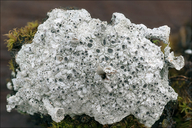|
|
click photo for larger file

Diploschistes muscorum
Crater Lichen
|
Photographer: Dr. Amadej Trnkoczy
ID: 0000 0000 0318 3485 (2018-03-22)Copyright © 2018 Dr. Amadej Trnkoczy
|
|
INFORMATION PROVIDED WITH THE PHOTO
|
date of photo Mar 20, 2018
latitude 46.35931 longitude 13.70001
View on Google Maps.
location
Lower Trenta valley, between villages Soča and Trenta, right bank of river Soča, Na melu place near Strgulc, Soča 46 abandoned farm house, East Julian Alps (Posočje, Slovenia)notes Slo.: ? - syn.: Diploschistes bryophilus f. parasitica (Sommerf.) Servít, Diploschistes lichenicola (Mont. & Fr.) Vain., Diploschistes scruposus f. bryophilus (Ehrh.) Oxner, Urceolaria scruposa f. parasitica (Sommerf.) Arnold - Habitat: Slightly inclined mountain slope, south aspect; a patch of stony grassland surrounded by trees and bushes (former pastures), Ostrya carpinifolia and Corylus avellana dominant; calcareous, skeletal, colluvial ground; full sun, relatively warm, dry and open place; exposed to direct rain; average precipitations ~ 3.000 mm/year, average temperature 7-9 deg C, elevations 615 m (2.020 feet), alpine phytogeographical region. Substratum: on thallus and podetia of Cladonia cf. pocillum, soil and mosses. Comment: Diploschistes muscorum is an interesting, cosmopolitan lichen living on ground. When young it parasitizes other lichens of Cladonia pyxidata group (Wirth 1995), especially Cladonia rangiformis and Cladonia pocillum (Dobson 2005). In this observation the host seems to be Cladonia pocillum. It gradually incorporates the algae of the host in its own thallus (Brodo 2001) and thus kill it. When mature it becomes free-living on mosses and ground without help of parasitism. It can grow to considerable sizes. This observation shows small, young specimens, max a few cm in diameter. Picture 3 shows a young specimen just becoming fertile, where lowest, outer squamules of the host are still alive and green. Picture 5c shows a podetium of the host thinly overgrown with Diploschistes muscorum thallus. Picture 2 shows an older specimen where no parts of the host can be seen directly, however, the shape of the thallus still resembles to some extent original shape of the Cladonia squamules. Later there is no more resemblance on Cladonia. Growing scattered. Several specimens found in the vicinity. Chemical reaction on thallus K-. Photographed in damp conditions. Ref.: (1) V. Wirth, Die Flechten Baden-Württembergs, Teil.1., Ulmer (1995), p 379. (2) I.M. Brodo, S.D. Sharnoff, S.Sharnoff, Lichens of North America, Yale Uni. Press (2001), p 304. (3) http://lichenportal.org/portal/taxa/index.php?taxon=52885 (accessed March 20. 2018) (4) F.S. Dobson, Lichens, The Richmonds Publishing Ca.LTD (2005), p 166. (5) C.W.Smith, et all, The lichens of Great Britain and Ireland,The British Lichen Society,(2009), p 380. (6) P.L. Nimis, Image archive of ITALIC, Dryades Project http://dbiodbs.units.it/carso/chiavi_pub52 (accessed March 20. 2018)camera Nikon D700 / Nikkor Micro 105mm/f2.8
contributor's ID # Sony ILCE6000 / Carl Zeiss Vario-Tessar E 16-70 mm/f4 photo category: Fungi - lichen
|
MORE INFORMATION ABOUT THIS FUNGUS
|
| common names
Crater Lichen (photographer)
View all photos in CalPhotos of Diploschistes muscorum Check Google Images for Diploschistes muscorum |
|
The photographer's identification Diploschistes muscorum has not been reviewed. Sign in to review or comment on this photo |
|
Using this photo The thumbnail photo (128x192 pixels) on this page may be freely used for personal or academic purposes without prior permission under the Fair Use provisions of US copyright law as long as the photo is clearly credited with © 2018 Dr. Amadej Trnkoczy.
For other uses, or if you have questions, contact Dr. Amadej Trnkoczy amadej.trnkoczy[AT]siol.net. (Replace the [AT] with the @ symbol before sending an email.) |
|
|
